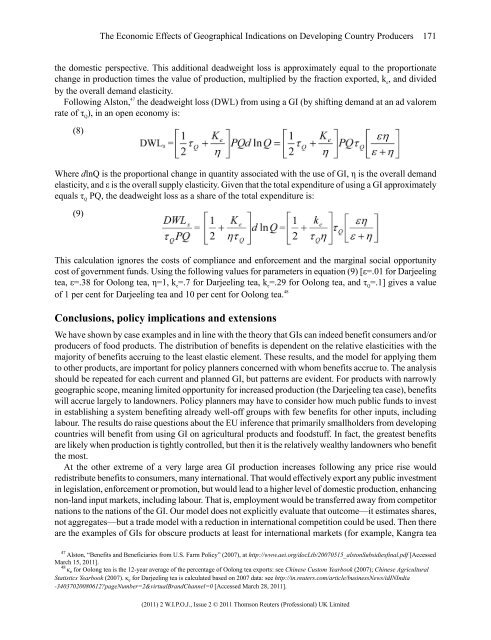WIPO Journal - World Intellectual Property Organization
WIPO Journal - World Intellectual Property Organization
WIPO Journal - World Intellectual Property Organization
Create successful ePaper yourself
Turn your PDF publications into a flip-book with our unique Google optimized e-Paper software.
the domestic perspective. This additional deadweight loss is approximately equal to the proportionate<br />
change in production times the value of production, multiplied by the fraction exported, k e, and divided<br />
by the overall demand elasticity.<br />
Following Alston, 47 the deadweight loss (DWL) from using a GI (by shifting demand at an ad valorem<br />
rate of τ Q), in an open economy is:<br />
(8)<br />
Where dlnQ is the proportional change in quantity associated with the use of GI, η is the overall demand<br />
elasticity, and ε is the overall supply elasticity. Given that the total expenditure of using a GI approximately<br />
equals τ Q PQ, the deadweight loss as a share of the total expenditure is:<br />
(9)<br />
The Economic Effects of Geographical Indications on Developing Country Producers 171<br />
This calculation ignores the costs of compliance and enforcement and the marginal social opportunity<br />
cost of government funds. Using the following values for parameters in equation (9) [ε=.01 for Darjeeling<br />
tea, ε=.38 for Oolong tea, η=1, k e=.7 for Darjeeling tea, k e=.29 for Oolong tea, and τ Q=.1] gives a value<br />
of 1 per cent for Darjeeling tea and 10 per cent for Oolong tea. 48<br />
Conclusions, policy implications and extensions<br />
We have shown by case examples and in line with the theory that GIs can indeed benefit consumers and/or<br />
producers of food products. The distribution of benefits is dependent on the relative elasticities with the<br />
majority of benefits accruing to the least elastic element. These results, and the model for applying them<br />
to other products, are important for policy planners concerned with whom benefits accrue to. The analysis<br />
should be repeated for each current and planned GI, but patterns are evident. For products with narrowly<br />
geographic scope, meaning limited opportunity for increased production (the Darjeeling tea case), benefits<br />
will accrue largely to landowners. Policy planners may have to consider how much public funds to invest<br />
in establishing a system benefiting already well-off groups with few benefits for other inputs, including<br />
labour. The results do raise questions about the EU inference that primarily smallholders from developing<br />
countries will benefit from using GI on agricultural products and foodstuff. In fact, the greatest benefits<br />
are likely when production is tightly controlled, but then it is the relatively wealthy landowners who benefit<br />
the most.<br />
At the other extreme of a very large area GI production increases following any price rise would<br />
redistribute benefits to consumers, many international. That would effectively export any public investment<br />
in legislation, enforcement or promotion, but would lead to a higher level of domestic production, enhancing<br />
non-land input markets, including labour. That is, employment would be transferred away from competitor<br />
nations to the nations of the GI. Our model does not explicitly evaluate that outcome—it estimates shares,<br />
not aggregates—but a trade model with a reduction in international competition could be used. Then there<br />
are the examples of GIs for obscure products at least for international markets (for example, Kangra tea<br />
47<br />
Alston, “Benefits and Beneficiaries from U.S. Farm Policy” (2007), at http://www.aei.org/docLib/20070515_alstonSubsidiesfinal.pdf [Accessed<br />
March 15, 2011].<br />
48<br />
κe for Oolong tea is the 12-year average of the percentage of Oolong tea exports: see Chinese Custom Yearbook (2007); Chinese Agricultural<br />
Statistics Yearbook (2007). κe for Darjeeling tea is calculated based on 2007 data: see http://in.reuters.com/article/businessNews/idINIndia<br />
-34037020080612?pageNumber=2&virtualBrandChannel=0 [Accessed March 28, 2011].<br />
(2011) 2 W.I.P.O.J., Issue 2 © 2011 Thomson Reuters (Professional) UK Limited

















